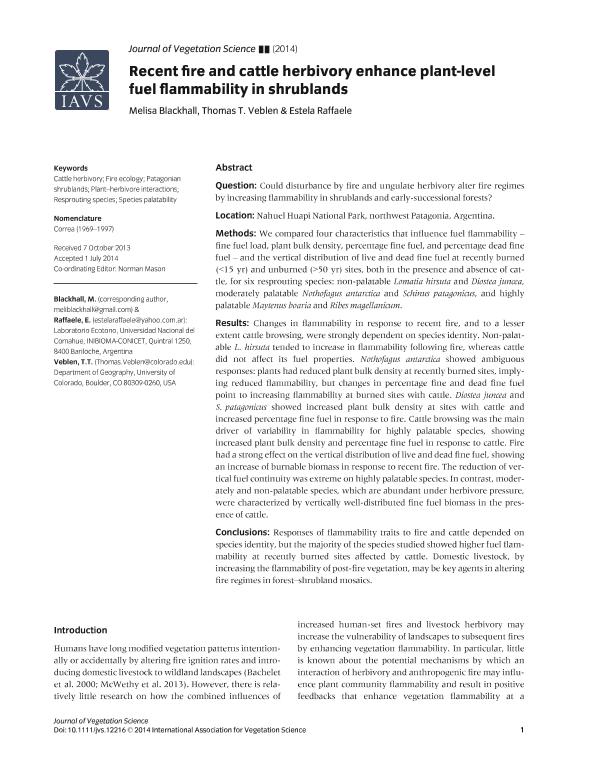Artículo
Recent fire and livestock browsing enhance plant-level fuel flammability in northwestern Patagonian shrublands
Fecha de publicación:
09/2014
Editorial:
Wiley
Revista:
Journal Of Vegetation Science
ISSN:
1100-9233
Idioma:
Inglés
Tipo de recurso:
Artículo publicado
Clasificación temática:
Resumen
Question
Could disturbance by fire and ungulate herbivory alter fire regimes by increasing flammability in shrublands and early-successional forests?
Location
Nahuel Huapi National Park, northwest Patagonia, Argentina.
Methods
We compared four characteristics that influence fuel flammability – fine fuel load, plant bulk density, percentage fine fuel, and percentage dead fine fuel – and the vertical distribution of live and dead fine fuel at recently burned (<15 yr) and unburned (>50 yr) sites, both in the presence and absence of cattle, for six resprouting species: non-palatable Lomatia hirsuta and Diostea juncea, moderately palatable Nothofagus antarctica and Schinus patagonicus, and highly palatable Maytenus boaria and Ribes magellanicum.
Results
Changes in flammability in response to recent fire, and to a lesser extent cattle browsing, were strongly dependent on species identity. Non-palatable L. hirsuta tended to increase in flammability following fire, whereas cattle did not affect its fuel properties. Nothofagus antarctica showed ambiguous responses: plants had reduced plant bulk density at recently burned sites, implying reduced flammability, but changes in percentage fine and dead fine fuel point to increasing flammability at burned sites with cattle. Diostea juncea and S. patagonicus showed increased plant bulk density at sites with cattle and increased percentage fine fuel in response to fire. Cattle browsing was the main driver of variability in flammability for highly palatable species, showing increased plant bulk density and percentage fine fuel in response to cattle. Fire had a strong effect on the vertical distribution of live and dead fine fuel, showing an increase of burnable biomass in response to recent fire. The reduction of vertical fuel continuity was extreme on highly palatable species. In contrast, moderately and non-palatable species, which are abundant under herbivore pressure, were characterized by vertically well-distributed fine fuel biomass in the presence of cattle.
Conclusions
Responses of flammability traits to fire and cattle depended on species identity, but the majority of the species studied showed higher fuel flammability at recently burned sites affected by cattle. Domestic livestock, by increasing the flammability of post-fire vegetation, may be key agents in altering fire regimes in forest–shrubland mosaics.
Palabras clave:
Cattle Herbivory
,
Fire Ecology
,
Patagonian Shrublands
,
Resprouting Species
Archivos asociados
Licencia
Identificadores
Colecciones
Articulos(INIBIOMA)
Articulos de INST. DE INVEST.EN BIODIVERSIDAD Y MEDIOAMBIENTE
Articulos de INST. DE INVEST.EN BIODIVERSIDAD Y MEDIOAMBIENTE
Citación
Blackhall, Melisa; Veblen, Thomas T.; Raffaele, Estela; Recent fire and livestock browsing enhance plant-level fuel flammability in northwestern Patagonian shrublands; Wiley; Journal Of Vegetation Science; 26; 1; 9-2014; 123-133
Compartir
Altmétricas




